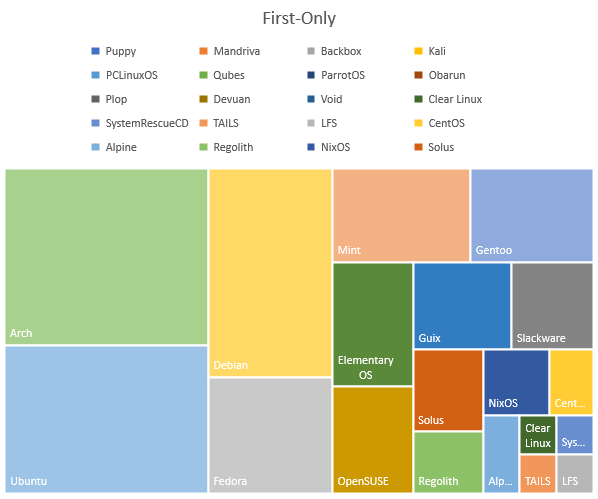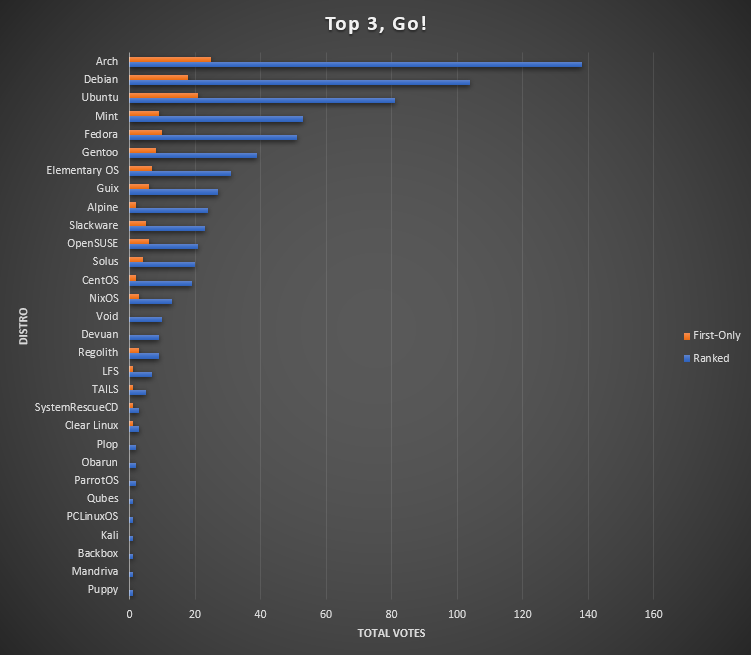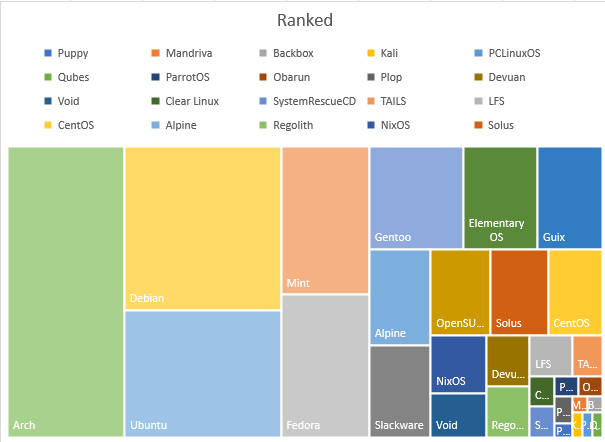Top 3, Go!
Introduction
Most of you reading have probably participated in some sort of election in the past. Whether it be a federal election, state/province election, or even an election for class president, they’ve all had a single thing in common:
You got one vote.
You only got a single vote and if you tried any shenanigans like marking off two candidates, or trying to “split” your vote into halves and give half a vote to two candidates, your vote was discarded. This is half because of course, you only get one single whole vote, but also because with that rule, you can’t have the ballot counter selecting your vote for you. This kind of vote is called a spoilt vote.
There’s also several other ways a ballot can be considered spoilt.
This kind of single vote system is called a plurality voting system. The name is a little counterintuitive but the meaning behind it is that you must win a “plurality” of the votes to be elected into the office being voted on. Within plurality voting there are several different voting systems such as first-past-the-post (the choice in Canadian federal elections), as well a single non-transferable vote, and a few others.
Ranked Voting
This is pretty much how federal and provincial/state elections take place around the world. Although, it’s not the only way to run elections as evidenced by the few countries that have implemented ranked voting systems. Notable examples of these countries are Australia, Ireland, the United States of America in their Democratic Party primaries, and Canada in elections of leaders of the three largest political parties.
Lately, especially with the US presidential election coming up, talk about ranked-choice voting has become more prevalent, with some states even petitioning to change to ranked-choice voting.
What is Ranked Voting?
Ranked voting systems are elections wherein each voter receives a preferential ballot and, based on the rules and regulation set in the given election, marks off several of their preferred candidates.
Just to make this a little clearer:
You have candidates A, B, C, D, and E. On the ballot you mark in the boxes beside the candidate you prefer, a number. From 1-3 you are marking your most to least preferred candidate.
Up until here, it’s pretty simple to understand. This is also exactly where simplicity stops. Ranked voting, just like many other topics, goes fractal in its depth and complexity. There are multiple types of ranked voting systems. From that point, there are also variants of each voting system!
Positional Voting
This is the simplest to explain and understand, and you may have already encountered this type of ranked voting system before. The basic concept is that each level of preference across all ballots is considered to be worth a certain amount of points. For simplicity, I’ll say that in my example election, first, second, and third preferences are worth 3, 2, and 1 points, respectively.
All the ballots’ preferences are then counted and totalled. The candidate with the most points overall, wins the election. This is still technically a plurality being one, but because the voter gets a preferential ballot, it is still considered ranked voting.
Instant-Runoff Voting
This ranked vote evaluation system is a little bit more complex but involves the least amount of effort on the part of human ballot counters (imagine you had rats counting these votes, though? Would be interesting).
The instant-runoff voting (IRV) method of evaluating ranked votes goes like this: All of the first-preference votes on all the ballots are counted and totalled. If a candidate reaches a majority, then they win the election.
If no candidate reaches a majority in the vote, then the candidate with the least amount of first-preference votes has their ballots’ first preferences discounted. Those votes are then redistributed among the other candidates by counting the second-preference vote of the relevant ballots. This process repeats until a candidate reaches a majority, which in this method is inevitable.
There is certainly a potential to have this require more effort required in manual ballot counting compared to positional voting, but more often than not, this is not the case. This is part of what makes IRV one of the more common ranked voting methods used in the elections that use them.
Condorcet
This has to be the most computationally complex of all the ranked voting systems. I say computationally because if you try to implement this manually, you’re kind of insane.
Condorcet voting systems are based on pairwise competition between the candidates. Between all possible combinations of two candidates in a given election, ballots are considered for preference between a given two candidates. If, between candidate A and B, A has more ballots that rank them higher than B, then A will win that pairwise competition.
Once all combinations have been considered and all ballots compared, the candidate with pairwise wins against all other candidates becomes the elected official for the given vote. Some Condorcet methods also accept either the most pairwise wins or a majority of the wins as the indicator of the winner.
Rising Interest
Money
It’s no secret that elections cost money to run. Between renting the space to conduct ballot collection, to paying the folks to supervise an elections, and on top of that, paying the folks who process the ballots. Then you have the cost of all the materials involved (printers, toner for said printers, banners, the paper you cast your vote on or the electricity needed to run voting machines), the maintenance of all the materials involved (especially with voting machines), and also the transportation costs for all the physically casted ballots.
This all doesn’t take into account the time allotted for citizens to skip part of their work day to have enough time to vote, their transportation costs, and then in COVID times, all the extra sanitary measures needing to take place on both sides of the voting aisle (voter vs. ballot collectors, etc, not political aisle).
Altogether, even a municipal election can become a multi-million dollar affair in most cities you know the names of. Now imagine you get the case wherein you have an election where no candidate reaches a majority and a majority win is required for a given office to change the butt sitting in the given chair. This multi-million dollar affair can quickly baloon into several elections taking place in a year, thus multiplying the cost it would take to run an election.
In the case of the IRV ranked-choice voting method, you would never have this case as the lack of a majority win prompts a hypothetical second round of counting where all second-preference votes are now considered. You essentially are having folks come up to the polls multiple times, but all at a fraction of the cost of a plurality voting system.
Wasted Votes
I’ve heard this one argument proposed for not voting for fringe-type party X (like the Green Party or the Pirate Party in some places): “Why would I vote for the Green Party if I just know they’re not going to win? I’m just wasting my vote so I might as well vote for .”
It’s a classic argument that has netted incumbents millions of votes. In Canada, we have the Liberal and Conservative parties, with a little bit of NDP in the Prime Minister seat over the past few decades. The default has been to vote for the one you prefer to win among the ones you think could win. This leaves little representation for smaller parties who are more likely to encompass the perspective of a more diverse set of people and who also have a much smaller budget.
This smaller budget also leads to less visibility due to lacking funds for marketing campaigns in favour of paying for transportation in meet and greet situations. So what happens? The folks with the biggest pool of cash become the most visible, netting them larger pools of cash due to their visibility. It’s self-fulfilling and leads to parties too big to fall.
Votes go to the most visible, not the most desired, candidates. All others are considered “wasted votes”.
Catering
It’s no surprise that the issues that candidates focus on have to do more with what’s popular in a given moment. Why? It’s the issue that’ll attract the most attention. It’s like riding the bandwagon.
Candidates look into what issues are most on people’s minds, what is being most reported on, what is getting the most attention around election times. You can see it with the way that some candidates flip-flop on their platform stances (because the majority opinion changes over time). What this does is almost guarantee that they get some sort of visibility, while also oh so easily catering to the largest group of people they can.
Contrast this with a ranked voting system where you being the topmost candidate isn’t the most important part anymore. What happens is something that Libby Schaaf, mayor of Oakland has been saying for years, “As a candidate, you have to talk to everybody, even people who you know you’re not their first choice.”
You don’t get to just pander to your base anymore because it’s not them you have to convince anymore. You also have to cater to the folks either adjacent or even opposite to your voter base. You have to talk about the issues that impact the most people, not just the ones that are making headlines around election time.
CommonCause, a watchdog group based in Washington, D.C., says that “[ranked voting] forces [candidates] to reach beyond tribal bases to build consensus across a broad range of constituencies.” You can’t just rely on instinct and us vs. them tactics because it doesn’t have to be us v them in a ranked voting system.
Spoiler Candidates
With the recent accusations against the Kanye West birthday party campaign, I think it would be apt to use his situation as a demonstration as to what a spoiler candidate is.
The spoiler effect is the effect of splitting votes between two or more similar candidates, often in an effort to favour the opposition or dissimilar candidate. A spoiler candidate is one that is employing that tactic by putting themselves on the ballot.
West’s campaign wouldn’t be the first one to collaborate with an opposing candidate’s campaign but with the dubious canvassing methods employed, West’s ties to the Trump campaign are in question following news that Kanye met with, Senior Advisor to the President, Jared Kushner. Kushner and West say that this meeting was to discuss Black empowerment.
Many discussions around West’s campaign centered around black voters. One of the most prominent topics discussed concerned Republicans’ willingness to plug Kanye as a frontrunner in the upcoming election, citing that their intention is to distract black voters. And Kanye himself says he has no problem with siphoning black votes away from Joe Biden, increasing Trump’s chances of winning.
As you can see from the recap of events above, it’s not hard to believe that Kanye West’s campaign may have been an attempt at spoiling the vote.
With ranked voting systems, however, since it’s not a one-and-done situation, votes for Kanye would have been discounted or insignificant, especially in an Instant-Runoff system.
Can Ranked voting solve the problem?
Well…I wish I could say yes, but I can’t honestly tell you that because I just don’t know. All of the problems with plurality voting listed above are certainly concerns that could be mediated by ranked voting systems. The problem is there isn’t much solid data out there proving for sure that ranked voting systems are truly the solution.
Until a few longitudinal studies are out there, arguing for RCVs is purely anecdotal.
What I can say though is that RCVs would be a welcome change, at least from the perspective of the citizen. RCVs are known to be more costly, more confusing (at least up front), and less trusted because they aren’t so widely adopted. RCVs don’t come without their disadvantages, but I think the benefits outweigh the drawbacks and in the long run, can bring an end to a two-party system like what we see in the USA.
Fun Fact: Zimbabwe used Instant-Runoff voting between 1979-1985, but only for caucasian candidates. Odd.
Modus Operandi
The inspiration for this post started out as a vote between some of the top preferred Linux distributions. I wanted to compare the results between a plurality vote and a ranked-choice vote. The results will come, but first I’d like to express a little bit about how I conducted this vote and my mentality going into the vote.
Methods
I’ll publish a separate post on my methodology but here is an overview: On mastodon, I posted a toot asking folks to rank their top 3 favourite Linux distros (GNU/Linux is what I wrote in the post).
Then, after an unspecified amount of time, once I noticed the votes were slowing dramatically, I decided to collect what I had. If someone submitted their vote after that point, it was not counted.
The first-mentioned distro in a given toot was taken as the plurality vote entry and the highest ranked vote when considering the toot in a ranked-choice vote. The second and third mentioned distros were taken as second and third highest ranking in a ranked-choice vote.
When compiling all the votes, I used a positional voting system to calculate the results of the ranked-choice vote as it was the easiest to implement in an excel spreadsheet.
Filtering
Overview: I discounted similar votes included in the same toot (example specifying both Arch and Manjaro) counted as a single vote towards Arch, and the highest position mention of the two distros was taken as the one that would be kept.
Example: “Arch, Manjaro, Ubuntu” would mean one highest-rank vote for Arch, and one second-highest vote for Ubuntu
Some folks also submitted troll-ish responses. As much data was kept as possible from these submissions in an effort to keep the voting base as diverse as possible.
Results!
Below are some charts I compiled out of the submissions received between the posting of the toot and the 25th of July.
Plurality Vote Results (orange bars)
As you can see below, Arch came out on top by a minimal margin, followed by Ubuntu, which was followed by Debian with an even smaller margin between it and Ubuntu. Then the votes eventually drop off slowly but surely until Void, Devuan, and others have absolutely no representation in the vote.

And here is a different way to represent the same results.

Ranked-Choice Vote Results (Positional) (blue bars)
In the positional voting results, you can see there’s a lot more representation for the smaller Linux distros, and that even some of the ranks have changed! Debian and Ubuntu actually switched places, and even Fedora and Mint switched places! In the end, Arch still reigned as the top Linux distro in this vote.
Void, in the ranked-choice vote, not only got representation, but it ended up beating out distros like TAILS, Linux From Scratch, and even Regolith!

And here’s the same results represented in a tree map.

Conclusion
This was way more effort than I intended to put into this post but I’m glad I did. I learned a lot about ranked-choice voting systems. I figure I was also able to demonstrate some of the numbers-related effects of a ranked-choice voting system.
Should I repeat this type of experiment, I would do a little more research before jumping into the project, especially publicly.
In the next Top 3, Go! post I’ll talk a little more about the methodology, the filters, and the actual numbers that I compiled together. I’ll also post the collected data and how I came to the results you see above.